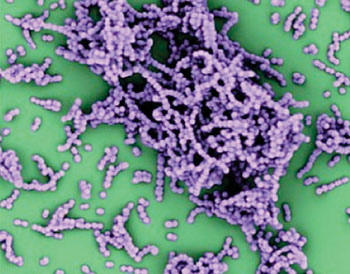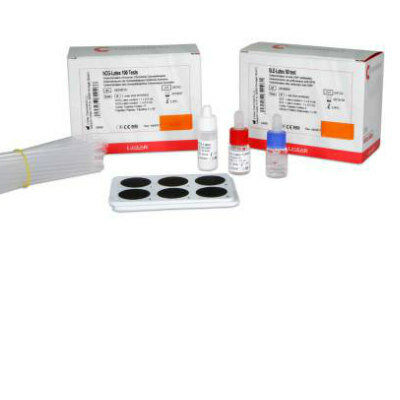Creation of a Weakly Virulent Strep A Mutant May Boost Vaccine Development
By LabMedica International staff writers
Posted on 24 Jun 2014
Creation of a mutated variety of Group A Streptococcus (GAS) bacteria with reduced virulence but complete immunological expression may pave the way for development of a safe vaccine to prevent infections such as strep throat, necrotizing fasciitis, and rheumatic heart disease, which are caused by these organisms.Posted on 24 Jun 2014
All GAS serotypes express the Lancefield group A carbohydrate (GAC), comprising a polyrhamnose backbone with an immunodominant N-acetylglucosamine (GlcNAc) side chain, which is the basis of rapid diagnostic tests. No biological function has so far been attributed to this conserved antigen.

Image: Electron micrograph, false color, of group A Streptococcus bacteria (Photo courtesy of the University of California, San Diego).
Investigators at the University of California, San Diego (USA) recently identified the genetic locus for GAC and used this knowledge to create a strep A mutant that lacked the GlcNAc side-chain addition. They reported in the June 11, 2014, issue of the journal Cell Host & Microbe that this mutant was significantly less virulent than the wild type organism in two infection models, in association with increased sensitivity to neutrophil killing, platelet-derived antimicrobials in serum, and the antimicrobial peptide LL-37.
The investigators also showed that antibodies to GAC lacking the GlcNAc side chain and containing only polyrhamnose promoted killing of multiple GAS serotypes and protected against systemic GAS challenge after passive immunization.
These findings demonstrated that the Lancefield antigen played a functional role in GAS pathogenesis, and that a deeper understanding of this unique polysaccharide has implications for vaccine development.
“It is satisfying to find that a fundamental observation regarding the genetics and biochemistry of the pathogen can have implications not only for strep disease pathogenesis, but also for vaccine design,” said senior author Dr. Victor Nizet, professor of pediatrics and pharmacy at the University of California, San Diego.
“Most people experience one or more painful strep throat infections as a child or young adult. Developing a broadly effective and safe strep vaccine could prevent this suffering and reduce lost time and productivity at school and work, estimated to cost two billion USD annually.”
Related Links:
University of California, San Diego














